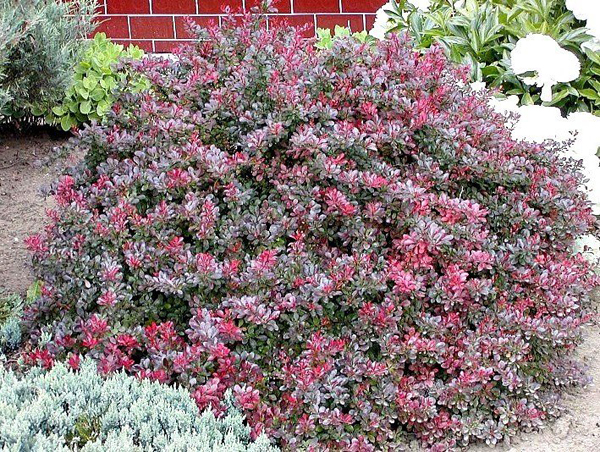Every gardener dreams of a beautiful plot. Of the majority of ornamental plants, barberry is extremely popular.. There are many varieties of this shrub. The barberry tunberg atropurpurea is considered one of the most unusual and colorful varieties.
Table of contents
Description of the barberry variety Thunberg atropurpurea
Barberry tunberg atropurpurea is a very beautiful and unusual shrub that is grown to decorate a garden or as a hedge.
Unfortunately, barberry fruits of this variety are not eaten, they contain a lot of alkaloids, because of what they are bitter and not tasty. They ripen in late October and are red, small and oblong berries that literally shower the shrub. Due to its appearance, the barberry often attracts the attention of birds, which helps, to some extent, to protect other fruit and berry plantations.
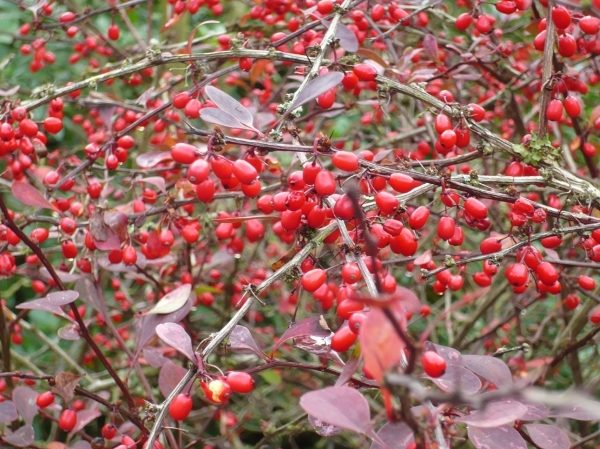
By the age of 5, the shrub grows up to 2 meters high and 3.5 meters wide. The dwarf form of barberry Atropurpurea is called Thunberg Atropurpurea nana. In the people, the barberry tunberg variety atropurpurea is called the red barberrythat explains the unusual color of the leaves. In the summer they are purple, in the fall the color becomes more saturated and turns into bright red. Green spots appear in the shadows on the leaves, therefore, in order to preserve the decorative appearance of the barberry, it is better to plant it in sunny places.
Blossom falls on 2-3 weeks May. The flowers are rounded in shape, they grow only up to 1 centimeter in diameter, usually they are collected in brushes of 3-6 pieces.The inner side of the flowers is bright yellow, and the outer purple-red.
The mountains of the Caucasus and the southern regions are considered to be the natural habitats of the shrub, but its frost resistance permits cultivation in colder areas.
Growing conditions
Red barberry has good winter hardiness, and you can grow it in almost any locality. It should also be noted the endurance of this plant in the sunlight, it is not afraid of not only frost, but also heat.
The only condition that must be observed during planting is sensitivity to soil moisture, it should not be dry, but the presence of nearby groundwater may cause the root system to rot.
Advantages and disadvantages
The only disadvantage of the barberry tunberg atropurpurea is the taste of the fruit, they are not suitable for consumption, and therefore this shrub is suitable for growing only as an ornamental plant.
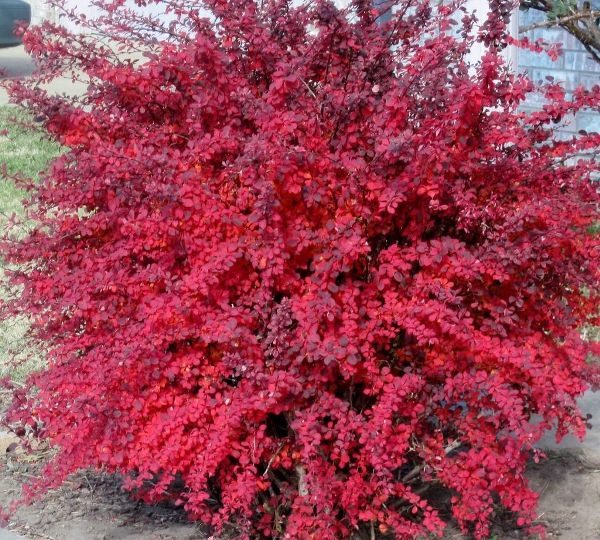
The advantages of this variety can be identified much more.:
- excellent and unusual appearance, the bright color of the leaves and the broad crown are well suited to create a hedge;
- bush not afraid of winter cold;
- longevity;
- grade not demanding to care and conditions of growth, tolerates heat, drought, etc .;
- bright berries allow you to divert the attention of birds, thus protecting other plants.
Landing rules
There are several rules, observing that the barberry shrub will decorate the garden area for a very long time. First you need to determine the place, it must meet the following requirements:
- necessarily large amounts of sunshine, shading can cause leaves to change color;
- even the barberry loves moisture, but its excess can destroy the plant, therefore avoid lowlands and places where precipitation and melting snow accumulate;
- also you can not plant barberries in places with high water table.
It is also necessary to prepare the soil in advance. If planting is carried out in the spring, the soil is prepared in the fall, and in the case of an autumn planting 3-4 weeks before work:
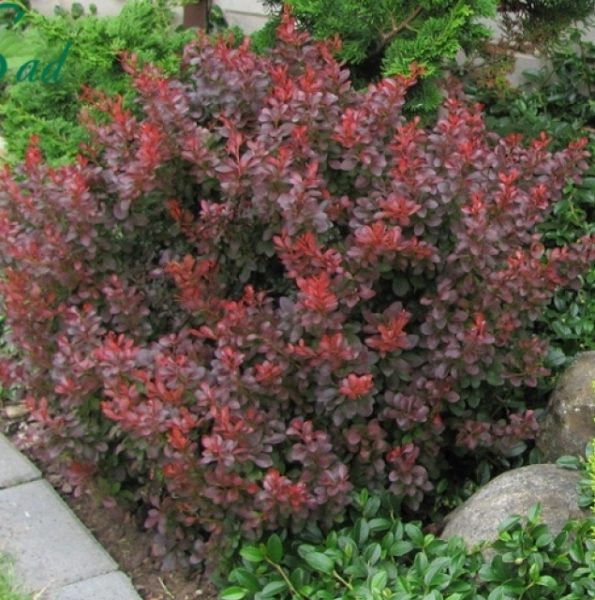
- No high acidity allowedtherefore, in the presence of this indicator, it is necessary to add lime or dolomite flour;
- Loamy or black soil need “Relieve” with peat or sand;
- Pit size depends on the age of the plant:
- before 2 years diameter and depth equal 25-30 centimeters;
- for aged shrubs before 3 years pit sizes will be 50x50 centimeters.
- During the excavation of the pit top the fertile soil layer is mixed with:
- 2 buckets of compost or humus;
- 2 buckets of sand;
- 100 grams of superphosphate.
The best time to land It is considered the beginning of spring, but it is also possible to produce work in the middle of October.
Before planting, the soil must be thoroughly moistened, and additionally watered after the seedling is in the ground. It is also recommended to mulch the soil.
Care
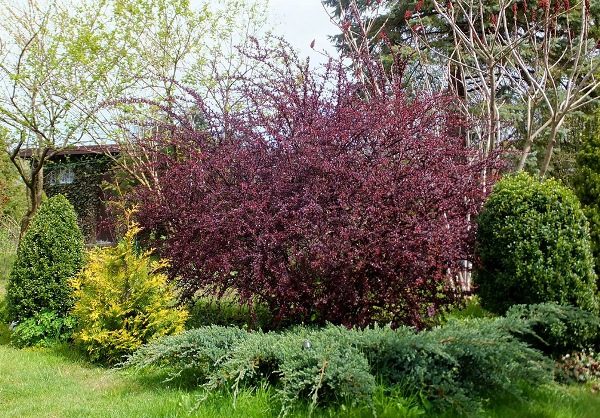
Like any other plant, barberry needs care. Adult shrubs are not whimsical to the frequency of watering, you can moisten the soil 2-3 times per month, the main thing should not be allowed to dry out. The young barberrywhich is still adapting to a new habitat, requires much more moisture, he is watered 1-2 times in Week.
After irrigation and weeding of the root zone, it is recommended to cover it. 5-7 centimeters a layer of mulch from sawdust, peat or other material. This procedure will help retain moisture and oxygen as long as possible.
Top dressing
One of the most important stages of growing shrubs is proper feeding. Although it is believed that barberry tunberg atropurpurea not picky about the quality of the soil, with its saturation of the shrub will look much more powerful and beautiful.
| Period | Fertilizer |
|---|---|
| In the spring, the next year after planting, in the future, this procedure is repeated 1 time in 4 years. | A young plant is watered with 30 grams of urea, diluted in 10 liters of water. As the shrub grows by 1 square meter of the root zone, 1 bucket of fertilizer will be spent. |
| Before and after flowering | For one adult shrub the following mixture is prepared:
|
| Late autumn after leaf fall | Mineral fertilizers are needed to prepare the plant for the winter. Under one bush pour 15 grams of superphosphate and 10 grams of potassium sulphide. If the weather is rainy, then the fertilizers are left dry, but if precipitation is not foreseen, it is best to water the plants so that the top dressing is dissolved. |
An adult barberry does not need a winter shelter, but a young and not strong shrub may die due to severe frost. Therefore, experienced gardeners recommend close plants with sacking for the winter before the onset 4-5 age.
Pruning
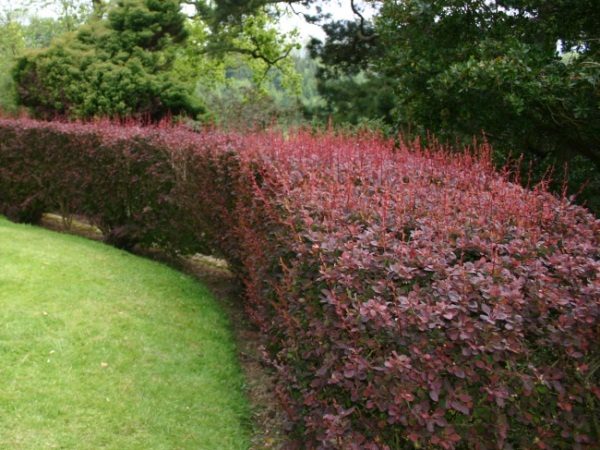
Barberry tunberg atropurpurea is grown as a decorative element, therefore in early spring, while the plant is at rest it needs to give the desired shape, the choice of which depends on the desire of the gardener. Usually, such a shrub is shaped into a ball. The barberry growing as a hedge is cut to the desired height.
Diseases and pests
Barberry is resistant to many diseases and pests, but still gardeners may encounter the following problems:
| Mealy dew or rust | It is possible to get rid of these diseases by treating the shrub with modern chemicals or with 1% solution of colloidal sulfur. |
|---|---|
| Barberry saw | Processing plants 1 or 3 percent solution of chlorophos. |
| Barberry aphid | Well helps the solution, in the process of preparation of which 150 grams of soap is diluted in 5 liters of water. |
Reviews
Olga: My mother started growing the red barberry, and from that time on our site there is a bright hedge.Our bushes are more than 30 years old. Of course, I cut them off every year, but they look just wonderful. This is an ideal option for a lazy grower.
Victor: I read somewhere that the berries of barberry attract the attention of birds, decided to plant and did not regret, besides the distracting effect that I wanted to achieve, I got a beautiful and unusual plant on my plot that pleases the eye and attracts the attention of neighbors.
Anastasia: decided to do landscaping the garden, a familiar landscape designer advised barberry tunberg atropurpurea, planted and did not regret their choice. The bush magnificent and beautiful, perfectly fits into any decorative composition.
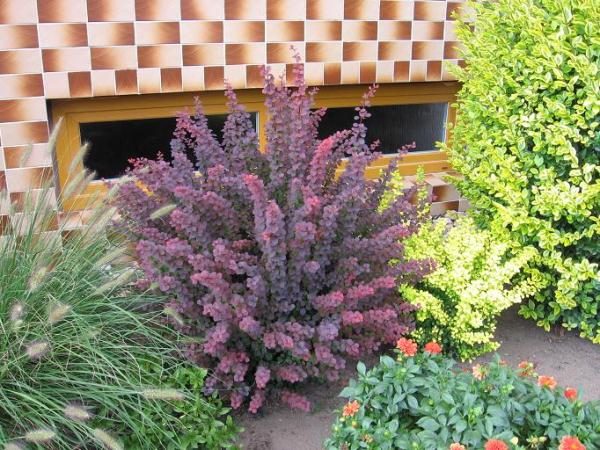
Barberry tunberg atropurpurea will be a great element of any landscape design.. In addition, such a plant does not require special attention and even an inexperienced gardener can handle it.
